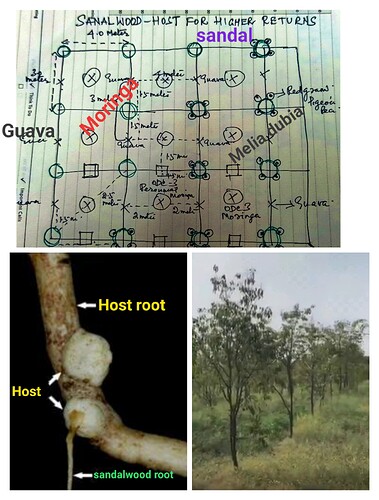SANDALWOOD - HOST CROP GEOMETRY FOR HIGHEST ROI
Sandalwood is a long duration crop requiring minimum 15 years to get income of Rs.5.0 crore per acre . Intelligent fixing of suitable host crop that also bring significant income between planting and harvesting of sandalwood is essential in commercial sandalwood farming .
333 sandalwood saplings are planted at 4×3 M spacing that yield an income of Rs.5.0 crore at 15 th year
333 guava saplings as host are planted each in the middle of two sandal plants along the row that gives income from 2nd year to 7-8 year - 333 trees × 20 kgs fruit × Rs.30 = Rs.2.0 lac every year and establish haustorial link with sandal root at 1.5 M
333 ODC 3 perennial moringa as host are sown each in the centre of 4 sandal . This gives income starting first year 333 trees × 25 kgs × Rs.25 /kg = Rs.2.0 lac / yr for 10 years . Establish haustorial connection with sandal root at 2.5 M distance
333 melia dubia timber value saplings are planted each in the centre of two sandal across the rows of sandalwood saplings . This produce income of Rs.80 lac at 10 th year . And connect as host with sandal roots at 2 M distance
Pigeon pea is sown as short term host in 30 CMS radius around each sandal saplings .
Sandal needs to link with roots of host within 2 years
is 1 acre an optimum size ? Planting methodology ? Where do you suggest one shd get sandalwood saplings? Is clayey soil where paddy is grown is suitable ? Mila Dubia needs wind breaks ? And tissue culture or natural saplings are good ?
I have just given calculation for one acre .Optimum size depends on the capacity of the farmers to invest and manage .Planting methods vary depending on the soil type , host crop , desire to grow roots as economical part , Clary soil can also be used with appropriate provision for drainage , melia dubia does not need windbreak and it does multiple function like host crop as well as timber yielding tree crop , sandalwood does not respond well to tissue culture propagation and natural saplings raised through careful selection of seeds from promising mother plants are good
